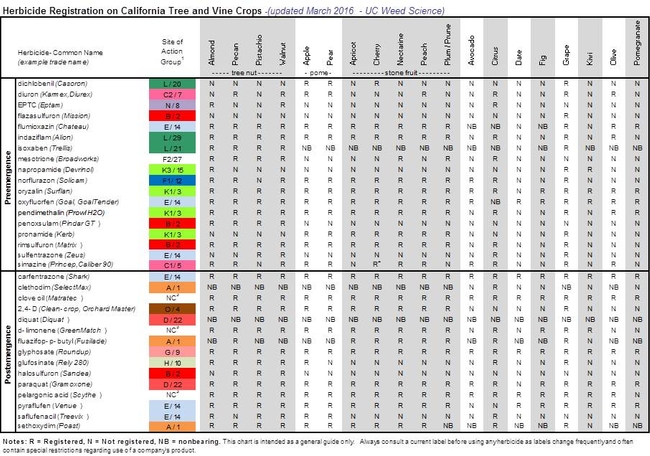- Author: Brad Hanson
I found out today that I previously misread the label of a new herbicide registered in several California orchard crops.
Broadworks Herbicide (from Syngenta) was registered in fall 2015 on several citrus, stone fruit, and tree nut crops (but not every crop in those groups).
I'm not entirely sure if I misread the label or if I simply made a typo when I last updated the T&V Herbicide Registration chart (which is totally possible after you've read several dozens of labels). At any rate, I erroneously listed mesotrione as registered on peach in my November update of that chart; however, Broadworks is not actually currently registered on that crop.
My apologies for any confusion this may have caused.
Here are the crops Broadworks is registered on as well as a current label.
- Citrus fruit (citrus hybrids, grapefruit, lemon, lime, sour orange, tangelo, tangerine (Manderin), cultivars, varieties, and/or hybrids of these)
- Stone fruit (nectarine, plum, cultivars, varieties, and/or hybrids of these)
- Tree nuts (almond, hazelnut (filbert), pecan, pistachio, black walnut, English walnut, cultivars, varieties, and/or hybrids of these).
I made an editor's correction to a previous post on this blog about mesotrione herbicide and have attached an updated version of that T&V herbicide registration chart below as well as at its semi-permanent address at the Weed Research and Information Center (click HERE for a direct URL to the chart at WRIC)
Please remember to refer to a current label before applying any pesticide as labels to change (and can be misread or misunderstood on occasion).
Brad
Tree and Vine crop herbicide registration 031616
Broadworks Label




Since the label indicates "nectarine, plum, cultivars, varieties, and/or hybrids of these" I'm still confused about whether peach is "in" or "out".
I'll seek clarification on what, if anything, that botanical fact means for Broadworks and peach in California; however, I think the safe move is not to use it on peach for the time being.
After reading the label I would say that peaches are in. The same argument would apply to cherries, apricots, pluots etc. They are stone fruit so should be in. If peaches are out because they are not specifically listed then cherries and apricots should be out too.
You didn't provide quite enough information to determine your rate. What GPA was your equipment calibrated at? Or, how many acres do you treat with one 150 gal tank load?
If you apply 50 GPA, you'd treat 3A per load and would need 18 oz of that herbicide in the tank to achieve 6 fl oz/A. If you apply 30 GPA, you'd treat 5A per load, and would need 30 fl oz of product to achieve the target rate.
From the other angle, if you mixed 32 oz of the product in 150 gal, you'd need to apply each load to 5.33 A (treated acres, which I assume is strips only). So given that, apply 150 gal of spray solution to 5.33 A would give you 28.15 GPA. Is that what you calibrate your equipment at? If significantly different that that, you may have a rate issue (particularly if you treat fewer acres than that).
You didn't mention where you are, but if your site has very sandy or coarse soils and if the application was made during the irrigation season, those factors can also influence the possibility of crop response.
Good luck,
Brad